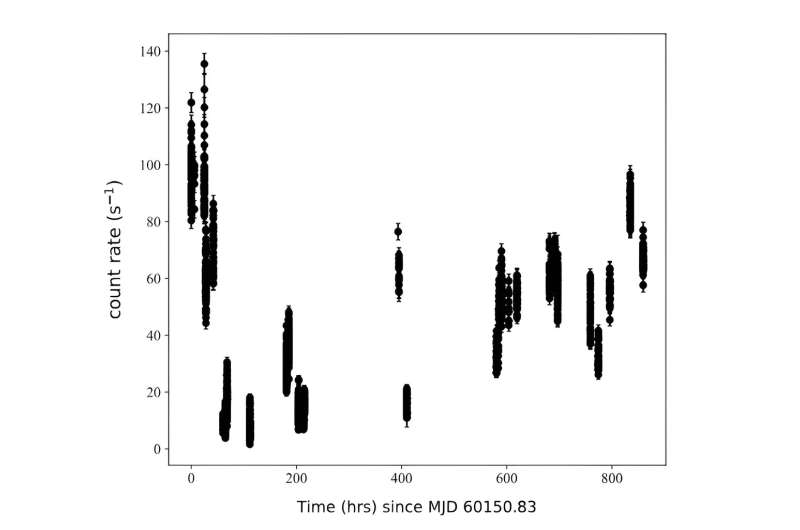July 4, 2024 report
This article has been reviewed according to Science X's editorial process and policies. Editors have highlighted the following attributes while ensuring the content's credibility:
fact-checked
preprint
trusted source
proofread
Nova eruption of V1716 Sco inspected in X-rays and gamma rays

Astronomers from China and Taiwan have observed the nova eruption of V1716 Sco that took place last year, using various X-ray and gamma-ray space observatories. Results of the observational campaign, presented June 27 on the preprint server arXiv, provide essential information regarding the evolution of this nova.
A nova is a star experiencing a sudden increase in brightness and slowly returning to its original state, a process that could last many months. Such an outburst is the result of the accretion process in a close binary system containing a white dwarf and its companion.
V1716 Sco, also known as Nova Sco 2023, was detected when it erupted on April 20, 2023 at magnitude 8.0. Follow-up observations of V1716 Sco spectroscopically confirmed it as a classical (Fe II) nova.
Now, a team of astronomers led by Huihui Wang of the Henan University of Science and Technology in Luoyang, China, has investigated V1716 Sco in X-rays and gamma-ray bands. For this purpose, they used NASA's Swift, NuSTAR and Fermi spacecraft, as well as the Neutron star Interior Composition Explorer (NICER) onboard the International Space Station.
"We conducted a joint analysis of NuSTAR, Swift, NICER, and Fermi-LAT observations of nova V1716 Sco," the researchers wrote in the paper.
The observations found that the gamma-ray emission started a day after the optical eruption of V1716 Sco, with a test statistic (TS) value of 70. The duration of this gamma-ray activity with a TS value of above 4.0 lasted for 40 days. Moreover, harder X-ray emission was also observed by Swift a day after the optical eruption.
Therefore, the findings make V1716 Sco the first classical nova in which the X-ray detection by Swift is concurrent with gamma-ray emission, and the fourth classical nova showcasing gamma-ray emission concurrent with harder X-ray emission from NuSTAR data.
By analyzing the X-ray spectrum, the researchers found that the hardness ratio rapidly decreased over time and the observed emission entered the supersoft source (SSS) phase approximately 40 days after the nova eruption. Furthermore, NICER data allowed the astronomers to detect a quasi-periodic oscillation (QPO) in the SSS phase with a period of 79.10 seconds.
Trying to explain the origin of the detected QPO, the authors of the paper point to the spin modulation of the white dwarf as the most plausible hypothesis. However, they noted that the period of the modulations is not stable with time. This may mean that the hot spot region on the white dwarf's surface may shift with time, or the periodic modulation may have originated from a different mechanism, such as a stellar oscillation.
More information: H. -H. Wang et al, X-ray and gamma-ray study for 2023 nova eruption of V1716 Sco, arXiv (2024). DOI: 10.48550/arxiv.2406.19233
Journal information: arXiv
© 2024 Science X Network





















